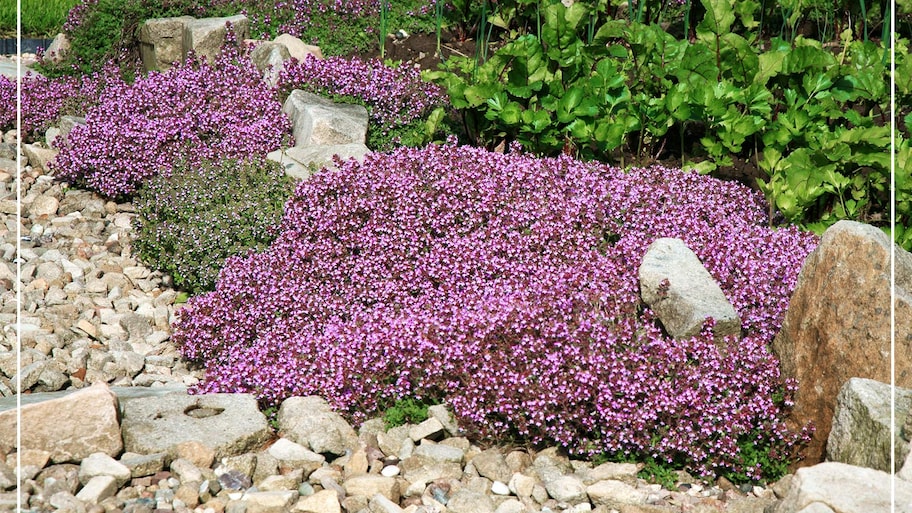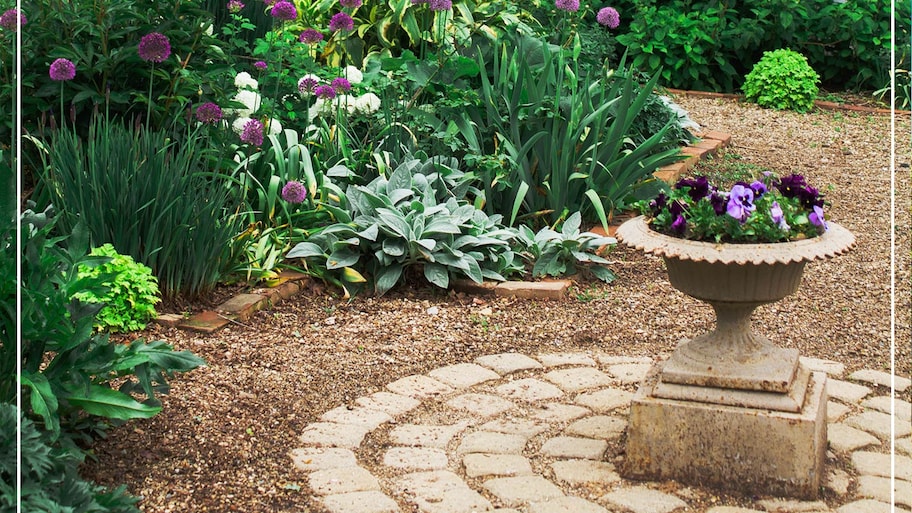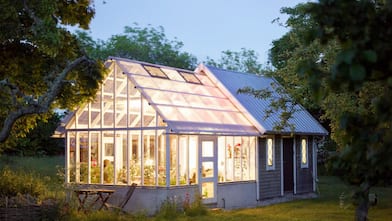Take the fuss out of lawn care by replacing your grass lawn with one of these low-maintenance replacements
There’s nothing more satisfying than stepping out of your front door onto a bright green lawn. A well-maintained lawn provides the perfect space for outdoor entertaining, family picnics, games, and lounging in the sun. However, grass lawns tend to come with hidden costs.
Grass lawns must be regularly mowed, watered, and fertilized. Not only can the cost of this maintenance add up over time, but herbicide runoff can sometimes negatively impact the surrounding environment.
If you’re tired of the investment that goes into sustaining a grass lawn, want to cut down on your environmental impact, or are simply ready for a total yard revamp, you’re in luck. There are many low-maintenance and eco-friendly options that can replace a stretch of turf. Below are 16 lawn alternatives to grass to inspire you to transform your lawn into an alluring, no-fuss outdoor space.
Low-Maintenance Ground Covers
Ground covers are low-growing plants that form a lovely sprawling blanket over the ground. Some can take a little bit of time to establish, but once they spread, ground cover plants are easy to maintain and make excellent no-mow lawn alternatives.
1. Creeping Jenny

Also known as moneywort, creeping Jenny is an evergreen perennial, low-growing plant with lime-green leaves on winding stems. Often planted in pots to spill over the sides, this plant can also wrap around stepping stones to create a charming and whimsical path. You can trim it occasionally if you want, and creeping Jenny can make for one of the most visually appealing ground covers.
Pros: No mowing necessary (can prune to keep looking tidy if desired), grows quickly
Cons: Requires some regular watering and fertilizing, and is an invasive species in some states
Best Growing Conditions: Low-lying areas, moist soil, sun to partial shade
2. Red Creeping Thyme

Red creeping thyme is an evergreen plant with bright, red-purple flowers that bloom in early summer. This ground cover sprawls to form a close-knit mat over the ground. Like creeping Jenny, it can be a great option to plant around a stone path or walkway. As a bonus, a red creeping thyme lawn gives off a sweet aroma and is even edible, which is perfect if you love gardening.
Pros: Drought-tolerant, little to no mowing (can prune to keep looking tidy if desired), bright color, edible, deer-resistant, tolerates foot traffic, attracts pollinators
Cons: Pricey, takes time to establish
Best Growing Conditions: Dry areas, well-draining soil, full sun
3. Stonecrop Succulents (or Sedums)

Stonecrop succulents, also known as sedums, are hardy plants with thick leaves that store moisture, allowing them to thrive in hot, dry regions. They come in a variety of colors, from shades of green and blue to purple, and add perfect texture in rock gardens, paths, and hilly yards.
Pros: Grows well in low-nutrient soil, requires little water
Cons: Takes time to establish
Best Growing Conditions: Hot, dry areas, well-draining soil, full sun
4. Sweet Woodruff

Sweet woodruff is a bright green, low-growing plant with star-shaped leaves and small white flowers when in bloom. Great for narrow passageways, paths, or a sweeping carpet of white flowers over a whole lawn, sweet woodruff is also an edible herb with a fresh scent.
Pros: Weed-resistant, little no mowing, little to no watering, no fertilizing, spreads quickly
Cons: Prefers shade
Best Growing Conditions: Cool areas, low sun
5. Moss

If you’ve never thought of moss as a lawn alternative, we get it, but it’s worth knowing that it can create a truly intriguing look for your ground cover. Once it’s given time to establish and spread, moss will form a soft, springy-textured lawn with a rich, green color.
Pros: No mowing, no fertilizing, grows quickly, can grow on different surfaces like rock, soil, and tree bark
Cons: Needs watering, can withstand only moderate foot traffic
Best Growing Conditions: Many species need cool, shady areas to thrive, but you can find varieties native to your specific region
6. Clover

Up until the mid-20th century, clover was actually included in common seed blends for lawns. Today, many are re-embracing clover as a lawn alternative because of its nitrogen-fixating properties, which enriches the soil and surrounding plants. With its white flowers, Dutch white clover is a popular option, while micro-clover has smaller leaves, flowers less, and creates a more uniform look.
Pros: Little watering, little mowing, no fertilizing, inexpensive, soil-enriching, drought-tolerant, will not discolor from pet urine, thrives in low-quality soil, green year-round, attracts pollinators
Cons: Can take a while to establish (need to keep moist and pull weeds), can stain clothing more than grass, cannot withstand high-foot traffic areas unless combined with grass, may need reseeding every two to three years, attracts deer, pest-resistant
Best Growing Conditions: Can grow in a range of soil types and sun levels
7. Corsican Mint

Corsican mint is a low-growing plant with small, bright green leaves and tiny flowers that bloom in early summer. With a pleasant, minty aroma, this ground cover can grow in diverse soil types. Plus, it works well around pathways, and for the resourceful gardener, it’s useful for culinary purposes.
Pros: Tolerates mild foot traffic, grows quickly, edible
Cons: Needs regular water and a little fertilizing
Best Growing Conditions: Moist, well-draining soil, full to partial sun

Flowers and Other Aesthetic Options
Flowers, shrubs, and ornamental grasses make attractive additions to any yard. While these aesthetically pleasing plants may not be the best options to cover the entire lawn, they can bring together grassy areas or other ground covers to reduce the size of a grass lawn.
8. Native Perennials

Because native flowers are adapted to the soil conditions of a particular region, they require very little fertilizing. Native plants are scenic and provide nectar for important pollinators like bees, hummingbirds, and butterflies. Choosing just a few colorful varieties will keep things low-fuss. Plus, they’ll look nice in an “island” around a tree or flower bed. Get in touch with your local nursery to find the best native perennials in your area.
Pros: Colorful, no mowing, little to no fertilizing, attract pollinators
Cons: Requires watering
Best Growing Conditions: Choose varieties native to your region
9. Shrub Beds

Like native perennial flowers, shrub beds native to your region can bring beautiful visual interest, texture, and unique shapes to your lawn. Shrub beds can stand alone or pair well with flowers as part of a flower bed.
Pros: No mowing, little to no fertilizing
Cons: Requires watering, trimming
Best Growing Conditions: Choose varieties native to your region
10. Ornamental Grasses

Ornamental grasses such as fescue, blue oat grass, fountain grass, and muhly grass grow into tall, fountain-like shapes that make compelling additions to any landscape. There are many of these versatile grasses to choose from, and they are easy to contain without spreading out of control. Simply trim them back each season to encourage new growth.
Pros: No mowing, drought-tolerant, won’t spread out of control, some varieties are pest-resistant
Cons: No foot traffic, requires watering, seasonal trimming
Best Growing Conditions: Grows well in most soils, most prefer sun (will differ by species)
11. Chamomile

Once established, Roman chamomile spreads quickly to form a short, neat lawn. Chamomile grows well in difficult-to-manage areas, such as a sloped yard, and is a great source of nitrogen for the surrounding soil. When in bloom, a chamomile lawn will boast white flowers with a pleasant aroma.
Pros: Little to no mowing, soil-enriching (good source of nitrogen), drought-tolerant, aromatic, grows quickly
Cons: Little watering, some varieties are toxic to pets
Best Growing Conditions: Partial to full sun
12. Snow-in-Summer

Snow-in-summer is a beautiful perennial that can cover partial areas of a lawn. Known for its stunning silver leaves, the plant also blooms in summer to form a blanket of thick, white flowers. As the name suggests, this plant can refresh your lawn with the wintery aesthetic of a blanket of snow.
Pros: Resilient, can grow in poor soil, spreads quickly, drought-resistant
Cons: No foot traffic, need to water when establishing, invasive in some areas
Best Growing Conditions: Dry areas, well-drained soil, full sun

Non-Plant Lawn Alternatives
Finally, the most low-maintenance lawn alternatives aren’t plants at all. With some strategic landscaping, non-plant alternatives can make for truly unique and stress-free lawns. Plus, these options also allow you to save the most time and money on water, mowing, and fertilizing.
13. Mulch

Mulch is a classic lawn alternative that is great for multiple purposes. Mulch beds can make up portions of your lawn or replace grass altogether. Mulch is great for covering difficult-to-mow areas and is perfect for flower beds and around trees. What’s more, there are many different types of mulch to choose from, such as pine bark, pine straw, and sustainable options like recycled mulch and compost. A simple, three-inch layer of mulch can add visual interest to your landscaping and requires far less upkeep than grass.
Pros: No watering, no mowing, many types to choose from, soil-enriching
Cons: Needs mixing and/or replenishing every few years
14. Sand

Sand can provide a clean base for an enclosed rock garden, an interesting accent space, a path, or a total lawn replacement. It can also make the perfect ground covering for a gathering area with lawn chairs and a fire pit. Sand provides good drainage and, once placed, doesn’t require much effort to maintain.
Pros: No watering, no mowing, inexpensive
Cons: Can decrease soil nutrients
15. Gravel

Incorporating gravel into your landscaping is an excellent way to create a pleasing, easy-to-manage environment around your home. Pea gravel, stone, and crushed granite are especially great alternatives for dry, hot regions where grass upkeep requires a lot of watering. Since gravel is a cheap alternative to a grass lawn, a stone and gravel company can help you easily spread granite over large areas.
Pros: No watering, no mowing, many types to choose from, long-lasting
Cons: Absorbs heat, will shift around if not contained
16. Artificial Turf

Last but not least is artificial turf: the lawn replacement that looks like grass, minus the maintenance. This alternative is popular for its water conservation and the ability to look bright and green all year-round. Just keep in mind that the success of your artificial grass will depend almost entirely on the quality of the product you choose and the expertise of the installation.
Pros: No watering, no mowing, durable
Cons: Absorbs heat

With any of these options, you’re sure to revitalize your outdoor space with a fresh look and cut down on yard maintenance. To get the most out of a revamped lawn, make sure to enlist the help of a local landscaping pro early on in the process.




